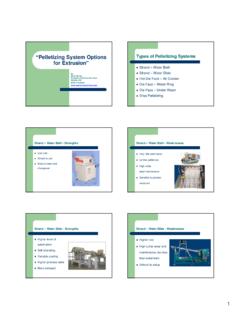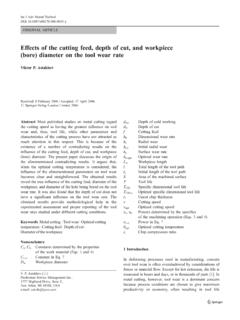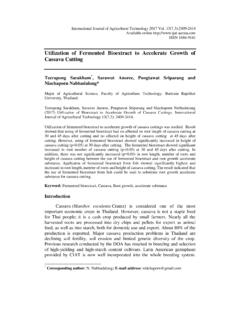Transcription of Making the Cut—Innovations in Plastics Pelletizing
1 Making the Cut Innovations in Plastics Pelletizing Phil Shoemaker, , VP Pelletizing Machinery, Rieter Corp. RIETER Corporation Pelletizing Machinery Spartanburg, SC 29305. USA. Over the past half century the number of pounds of Plastics processed has grown from 2 billion pounds per year to 200, and nearly all that plastic has to be pelletized, sometimes two or three times. Twin demands have emerged of the pelletizer make more pellets in a given time while also Making them more consistent. Some examples, 1). bottle resin producers must make their product within a very narrow size distribution range, with the pellets being cylindrical and remaining in a nominal weight range of 17- 25 mg; 2) color compounders must produce product that is free of fines and color cross- contamination, and 3) micropellet producers have to control the size distribution while increasing throughput.
2 In response to these increasing demands, manufacturers of pelletizers have developed broadly in two directions, refining and expanding the cold Pelletizing options while at the same time developing hot face cutting . Each system has its strengths and weaknesses. Plastics Pelletizing grew out of rubber processing technology: Two-roll mills into waterbaths, into dicers that pulled and cut the web into pellets. In the early 1950s Fredrick Roddy at Cumberland developed the first domestic pelletizer. From that time to now, the pelletizer has continued to evolve, so that now the family tree looks something like Figure 1. Cold Pelletizing Melt Pelletizing Dicer Strand Water ring Underwater Air cooled Pelletizing Pelletizing Pelletizing Pelletizing Conventional Self threading, Automatic Water free water bath belt type systems system FBG.
3 WSG JSG ATG USG FBG DROPPO. Dry cut Dry cut Dry Wet Dry Drop process cut cut cut Pelletizing Figure 1. Pelletizing Family Tree. Figure 2. Dicer, From Henion. Roddy's innovation was simply to divide the web into strands and then to replace the stairstep blades with straight knives that cut against a bedknife. Given the venerable nature of cold Pelletizing the technology has undergone improvement incrementally, focusing on ease of turn-around, pellet quality, power, safety, and noise reduction. Figure 3. Typical Strand System. Quality control programs demand quick and verifiable cleaning procedures, so as such programs have been implemented over the past couple of decades the strand pelletizer has also been upgraded to permit tool-less disassembly and rapid cleanout.
4 Nearly all vendors now permit access into the cutting chamber without recourse to tools. Removable feedrolls, even if driven, are now standard. Additionally, most horizontal surfaces inside the cutting chamber have been beveled to prevent the accumulation of pellets on those faces. Figure 5. Open cutting chamber showing removal of upper feed roll and swiveling stripper. Figure 4. Cutterhead showing beveled surfaces. Rotor Technology Manufacturers have replaced the straight, replaceable blade rotors with helical, solid body types. This accomplishes two objectives the continuous cutting action quiets the machine while the helical tooth slices into the strand more slowly, providing a cleaner cut, and the cleaner the cut, the fewer fines produced.
5 9. 9. Figure 6. Helical Effects The number and type of helical rotors have steadily increased, so that today rotors of various materials and with different helical angles are available. Helical rotors bring with them some trade-offs, however. The initial action of the tooth tends to scissor-cut the strand pushing it away from the tooth at low speeds, and when running at high speeds the helical angle tends to turn the strands in the direction of the helix. While shortening the relief land on the back of the rotor tooth fixes the latter problem, often this correction goes unnoticed. We think of the rotor as a rigid, unyeilding metal piece, and of the strands as soft, easily cut Plastics .
6 But just as the tooth presses on the strands, the strands press back on the tooth. If strands agglomerate in the center of the rotor, it wears prematurely. By working the tooth back and forth, the metal begins to fatigue, crack, and corrode due to this deformation. In those cases where strands are very hard and abrasive the usual recommendation is to go to a tungsten carbide rotor. Tungsten carbide rotors are less prone to metal fatigue and wear, but the material is expensive, brittle, and very hard to work. The earliest such rotors provided for a solid tungsten carbide blade bolted onto a rotor body. Later, long strips of the metal were clamped into a rotor body using wedges.
7 V1 Output Set: MSC/NASTRAN Case 1, Deformed( ): Total Translation, Contour: Solid Von Mises Stress L1. C1. Y. X 111. Z. 78. 78. 78. 78. Figure 7. Deformation of tooth under load. The latest development is the Meister rotor, which uses locking pins inside recessed blades in rotor segments. This prevents the blade from slipping out of the rotor body, as can happen with the older wedge-lock design. High loadings of glass-fibers cause high impact forces on the blade, which can tear itself out of the rotor. The positive interlocking of the tungsten carbide blades that utilize screw collets into the rotor body prevents such catastrophic failure of the rotor. Since the rotor body can easily come into contact with pellets after cut, abrasion of this item can be reduced using a nitrided steel.
8 Figure 8. Meister Design with locking collets. Wear Coatings Since Pelletizing is a kind of mechanical processing it involves friction, abrasion, and corrosion. Every part of the machine that comes into contact with either strands or pellets is exposed to wear, especially with rigid materials or abrasive additives like glass fibers. Different options of wear protection have been used, all of them aiming to increase the lifetime of the machine parts. The newest development in terms of wear protection is a stellite based surface coating, applied by high speed injection to metal surfaces. This innovative wear protection has been applied in some dry cut strand pelletizers that are producing 50 % glass filled PA-based compounds.
9 In the inital trial, all the major parts of the cutting head coming into contact with either strands or pellets had been coated. After a period of several months, under normal conditions these parts were inspected for signs of wear. None of them showed measurable degradation, the only visible sign was some mirror-like polished areas on some surfaces. Figure 9. Wear protection type VS 22 after several months of production. Based on these encouraging results, we now recommend this type of abrasion protection for any application with materials or ingredients that can generate excessive wear. The payback in terms of lifetime and reduced service cost is quite convincing. Developments in Bed Knives Several new types of bed knives have appeared lately upgraded tungsten carbide, different kinds of ceramics, and even diamond.
10 As is always the case, the best materials also cost the most. PCD (polycrystalline diamond) is a hybrid piece constructed of tungsten carbide with an insert of PCD. The cutting edge itself consists of a sintered diamond layer that is bonded to a tungsten carbide substrate via a ductile intermediate layer. It is produced of uniform sized and extremely clean micro-grains sintered under high pressure and temperature. PCD-elements are available only in small dimensions. For bed-knifes, a length of several hundred mm can be achieved by hard brazing of PCD- elements to a supporting metal holder. Out of wear resistance considerations, the supporting holder is made of tungsten carbide.











